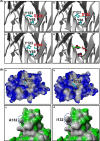High-affinity PD-1 molecules deliver improved interaction with PD-L1 and PD-L2
- PMID: 29890018
- PMCID: PMC6113430
- DOI: 10.1111/cas.13666
High-affinity PD-1 molecules deliver improved interaction with PD-L1 and PD-L2
Abstract
The inhibitory checkpoint molecule programmed death (PD)-1 plays a vital role in maintaining immune homeostasis upon binding to its ligands, PD-L1 and PD-L2. Several recent studies have demonstrated that soluble PD-1 (sPD-1) can block the interaction between membrane PD-1 and PD-L1 to enhance the antitumor capability of T cells. However, the affinity of natural sPD-1 binding to PD-L1 is too low to permit therapeutic applications. Here, a PD-1 variant with approximately 3000-fold and 70-fold affinity increase to bind PD-L1 and PD-L2, respectively, was generated through directed molecular evolution and phage display technology. Structural analysis showed that mutations at amino acid positions 124 and 132 of PD-1 played major roles in enhancing the affinity of PD-1 binding to its ligands. The high-affinity PD-1 mutant could compete with the binding of antibodies specific to PD-L1 or PD-L2 on cancer cells or dendritic cells, and it could enhance the proliferation and IFN-γ release of activated lymphocytes. These features potentially qualify the high-affinity PD-1 variant as a unique candidate for the development of a new class of PD-1 immune-checkpoint blockade therapeutics.
Keywords: PD-1; PD-L1; PD-L2; inhibitory receptor; phage display.
© 2018 The Authors. Cancer Science published by John Wiley & Sons Australia, Ltd on behalf of Japanese Cancer Association.
Figures






Similar articles
-
Blockade of programmed death-1 ligands on dendritic cells enhances T cell activation and cytokine production.J Immunol. 2003 Feb 1;170(3):1257-66. doi: 10.4049/jimmunol.170.3.1257. J Immunol. 2003. PMID: 12538684
-
The structural features that distinguish PD-L2 from PD-L1 emerged in placental mammals.J Biol Chem. 2020 Apr 3;295(14):4372-4380. doi: 10.1074/jbc.AC119.011747. Epub 2019 Dec 27. J Biol Chem. 2020. PMID: 31882544 Free PMC article.
-
Hantavirus-Driven PD-L1/PD-L2 Upregulation: An Imperfect Viral Immune Evasion Mechanism.Front Immunol. 2018 Dec 3;9:2560. doi: 10.3389/fimmu.2018.02560. eCollection 2018. Front Immunol. 2018. PMID: 30559738 Free PMC article.
-
Structural Biology of the Immune Checkpoint Receptor PD-1 and Its Ligands PD-L1/PD-L2.Structure. 2017 Aug 1;25(8):1163-1174. doi: 10.1016/j.str.2017.06.011. Structure. 2017. PMID: 28768162 Review.
-
[Progress in PD-1/PD-L1, PD-L2 signaling pathway and its role in host anti-tuberculosis immunity].Zhonghua Jie He He Hu Xi Za Zhi. 2024 May 12;47(5):485-489. doi: 10.3760/cma.j.cn112147-20230904-00133. Zhonghua Jie He He Hu Xi Za Zhi. 2024. PMID: 38706074 Review. Chinese.
Cited by
-
LAG3 immune inhibitors: a novel strategy for melanoma treatment.Front Oncol. 2024 Dec 18;14:1514578. doi: 10.3389/fonc.2024.1514578. eCollection 2024. Front Oncol. 2024. PMID: 39743998 Free PMC article. Review.
-
Dual and Opposite Costimulatory Targeting with a Novel Human Fusion Recombinant Protein Effectively Prevents Renal Warm Ischemia Reperfusion Injury and Allograft Rejection in Murine Models.Int J Mol Sci. 2021 Jan 26;22(3):1216. doi: 10.3390/ijms22031216. Int J Mol Sci. 2021. PMID: 33530581 Free PMC article.
-
Recombinant Expression and Purification of Extracellular Domain of the Programmed Cell Death Protein Receptor.Rep Biochem Mol Biol. 2020 Jan;8(4):347-357. Rep Biochem Mol Biol. 2020. PMID: 32582792 Free PMC article.
-
Phage Display-Based Nanotechnology Applications in Cancer Immunotherapy.Molecules. 2020 Feb 14;25(4):843. doi: 10.3390/molecules25040843. Molecules. 2020. PMID: 32075083 Free PMC article. Review.
-
An engineered PD1-Fc fusion produced in N. benthamiana plants efficiently blocks PD1/PDL1 interaction.Plant Cell Rep. 2025 Mar 22;44(4):80. doi: 10.1007/s00299-025-03475-0. Plant Cell Rep. 2025. PMID: 40119938 Free PMC article.
References
-
- Page DB, Postow MA, Callahan MK, Allison JP, Wolchok JD. Immune modulation in cancer with antibodies. Annu Rev Med. 2014;65:185‐202. - PubMed
-
- Carosella ED, Ploussard G, LeMaoult J, Desgrandchamps F. A systematic review of immunotherapy in urologic cancer: evolving roles for targeting of CTLA‐4, PD‐1/PD‐L1, and HLA‐G. Eur Urol. 2015;68:267‐279. - PubMed
MeSH terms
Substances
LinkOut - more resources
Full Text Sources
Other Literature Sources
Research Materials

